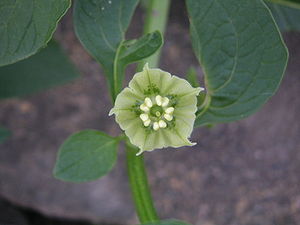Yaltomata procumbens
| Yaltomata procumbens | ||||||||||||
|---|---|---|---|---|---|---|---|---|---|---|---|---|

Yaltomata procumbens |
||||||||||||
| Systematics | ||||||||||||
|
||||||||||||
| Scientific name | ||||||||||||
| Yaltomata procumbens | ||||||||||||
| ( Cav. ) JLGentry |
Jaltomata procumbens is a plant type from the genus jaltomata in the family of the nightshade family (Solanaceae). The fruits of the Jaltomata procumbens are occasionally used as fruit.
description
Jaltomata procumbens are herbaceous plants up to 2 m high, the stem axis of which is hollow, green and hairless to tomentose. When the trichomes dry out, they turn white. The leaves are ovate, entire or slightly wavy-toothed. They are pointed at the top, the base is blunt or narrowed. The upper side of the leaves is hairless, only a few trichomes are found on the leaf veins. The leaf stalks are up to 5 cm long, often winged due to the narrow leaf base. Smaller leaves are often found, but they are also almost as large as the large type.
The golden inflorescences stand on a slightly hairy, unbranched inflorescence stalk up to 4 cm long, the flower stalks are thread-shaped, 1 cm long and extended to up to 3 cm on the fruit. The flowers are usually bent backwards, the calyx is about 2 to 3 mm long, the calyx tips are free up to about half the length of the calyx. The yellow to greenish-white crown often shows greenish points and measures 10 to 15 mm in diameter. The petals are fused to about half the length, the resulting corolla lobes are triangular or blunt. The anthers are ellipsoidal and about 2 mm long. In contrast to the very similar species Jaltomata repandidentata , all anthers of a flower are the same size. On the first day of the flowering period, the anthers are closed, they only open on the second day, and at the same time the stamens also lengthen. The stylus is enlarged-head-shaped and, in contrast to Jaltomata repandidentata, always straight.
The edible fruit is a slimy berry , black when ripe, with a diameter of 8 to 10 mm. As the fruit ripens, the calyx enlarges and becomes up to 1 cm long, has a noticeable central vein and does not wrap itself around the fruit. The fruits contain many indented lenticular seeds about 1 mm in size .
The base chromosome number is .
Occurrence
The species is distributed in Mexico and Central America to the Andes . The locations are at altitudes between 1000 and 2900 meters.
proof
Main source
- WG D'Arcy: Family 170: Solanaceae . In: Robert E. Woodson, Jr., Robert W. Schery (Eds.): Flora of Panama , Part IX, Annals of the Missouri Botanical Garden, Volume 60, Number 3, 1973. Pages 573-780
